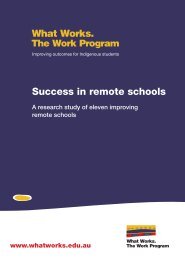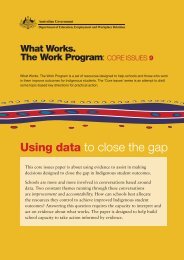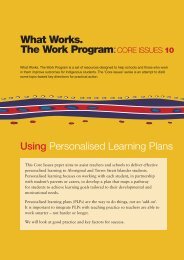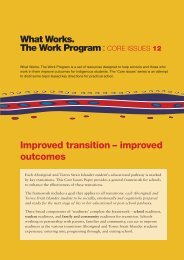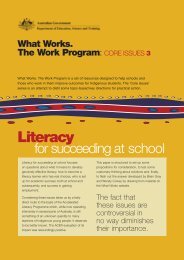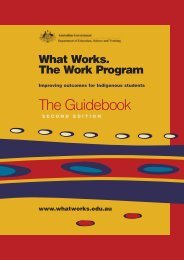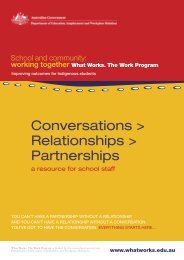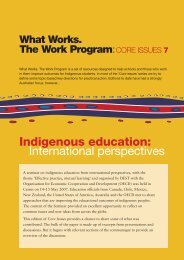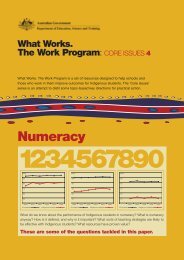Bound for Success Scope and Sequence Statements
Bound for Success Scope and Sequence Statements
Bound for Success Scope and Sequence Statements
- No tags were found...
Create successful ePaper yourself
Turn your PDF publications into a flip-book with our unique Google optimized e-Paper software.
TECHNOLOGYSystemsSystems are created from a series of interrelated components that work together.ConceptIn Year 1the student:In Year 2the student:In Year 3the student:In Year 4the student:In Year 5the student:In Year 6the student:In Year 7the student:In Year 8the student:In Year 9the student:Students identify <strong>and</strong>describe systems thatare appropriate toachieve solutions totechnology challenges.• Identifies <strong>and</strong> describessome of the features ofsystems which exist intheir local environment(e.g. says “wateringsystems have pipes, valves<strong>and</strong> taps”).• Designs <strong>and</strong> creates simplesystems to undertakefamiliar tasks within theclassroom <strong>and</strong> school (e.g.designs <strong>and</strong> creates aclassroom roster to waterthe plants in the room).• Explains the operationalsequence of familiarsystems (e.g. says “whendad was making thes<strong>and</strong>wich, he first put thebread out, then he butteredit, then he put meat <strong>and</strong>lettuce on the bottom bit;then he put mayonnaise onthe other piece of bread<strong>and</strong> put it on top”).• Describes the componentsof familiar systems, howsome of their majorelements operate <strong>and</strong> whothey are designed <strong>for</strong>. (e.g.says “my mum uses a faxmachine <strong>for</strong> work, sheloads the paper here, theprinting cartridge here<strong>and</strong> the fax comes outhere”).• Draws <strong>and</strong> labels simplediagrams of some ofobvious elements ofsystems created by others(e.g. students draw thefeatures of a simpleplumbing system such astaps, pipes <strong>and</strong> drains <strong>and</strong>suggest how a filter couldbe added to trickle thewater onto plants).• Knows that simplesystems are made up ofpeople <strong>and</strong> parts <strong>and</strong>identifies these (e.g. says“the watering system ismade up of a tap, a hose,some sprinklers <strong>and</strong> needsa person to switch it on”).• Describes <strong>and</strong> draws flowcharts of the inputs,processes <strong>and</strong> outputs ofsystems. (e.g. describeshow a production line -such as food line or avehicle manufacturing line- works <strong>and</strong> the stepsinvolved).• Describes the relationshipbetween the inputs,processes <strong>and</strong> outputs ofsystems <strong>and</strong> considerswhat might happen if onepart of the process ismodified or breaks down(e.g. says “We could addlaundry water to ourirrigation system butwould need a differentfilter <strong>and</strong> a tank to controlthe flow of water from thewashing machine to thetrickle pipes”).• Identifies subsystemswithin a system <strong>and</strong> thesequencing of theiroperation within thesystem (e.g. knows thatwhen building a house theelectrical appliances areinstalled after the buildingis finished <strong>and</strong> each ofthese are constructed offsite as part of a separatesystem).• Identifies theinterdependence of allelements of a system (e.g.crop production system:light, water, nutrients,plant support <strong>and</strong>protection) <strong>and</strong> recognisesthe significance of theirapplication through subsystemssuch as irrigation<strong>and</strong> disease control).• Underst<strong>and</strong>s that theelements, structure,sequences, operation <strong>and</strong>control of systemsinfluence the ways thatsystems interact withpeople <strong>and</strong> theenvironment (e.g.describes the impact onthe community <strong>and</strong> themanufacturer when<strong>for</strong>eign material such asmetal is found in amanufactured item such asa packaged cake).Students design, adapt<strong>and</strong> use systems thatare appropriate toachieve solutions totechnology challenges.• Draws a simple diagram(or sequence of diagrams)depicting the cause <strong>and</strong>effect notion of a system(e.g. diagram 1 ofsomeone turning on a tap,diagram 2 of water comingfrom a sprinkler <strong>and</strong>diagram 3 of grass <strong>and</strong>trees growing).• Designs <strong>and</strong> carries out asimple operationalsequence to produce aproduct (e.g. makes as<strong>and</strong>wich using a system;establishes an in-classmailing system).• Creates a simple system -with three or more parts -to undertake a task aroundthe home or school (e.g.creates a cooling systemusing a fan, spray bottle<strong>and</strong> water).• Suggests ideas <strong>for</strong>improvement <strong>and</strong>automation of everydaysystems, some viable <strong>and</strong>others not so viable (e.g.says “traffic lights couldbe modified with musicsystems so that peoplecould listen to music whilethey wait <strong>for</strong> the lights togo green”) <strong>and</strong> discusseswhy some design ideas areviable <strong>and</strong> some aren’t.• Organises <strong>and</strong> participatesin a simple system such asa production line to makea class product (e.g. helpsto design a better sportsequipment borrowingsystem or creates a foodmanufacturing system <strong>for</strong>a charity fund-raisingevent).• Identifies a fault in asystem <strong>and</strong> acts to fix it(e.g. sees that the screenprinting system isproducing a ‘bleed’ in thefinished print <strong>and</strong> mendsthe tear in the wire mesh,or notices that their solarpoweredcar isn’t going asfast as it should <strong>and</strong> cleansthe cells).• Knows that systems canbe combined in new waysto create better or morerefined systems <strong>and</strong>subsystems ( e.g.combines a torch <strong>and</strong> fanto create a device that willgive light <strong>and</strong> keep themcool when camping).• Creates systems (oftencalled protocols) to ensurethat all parts of the systemcontinue to work well (e.g.when using a sewingmachine they design asystem to ensure thequality of the finishedgarment - first check thebobbin, then the tension,then that the machine isthreaded correctly <strong>and</strong>then sew a sample.• Examines the systems ofothers (e.g. looks atprocesses used to makeburgers in a fast foodchain) to identify the‘quality assurance’processes.• Selects <strong>and</strong> safely usesprocedures <strong>and</strong> techniquesappropriate to safetyst<strong>and</strong>ards <strong>and</strong> workplacedesign to monitor <strong>and</strong>maintain sub-systemswhile adhering toenvironmental <strong>and</strong>/orhealth <strong>and</strong> safety st<strong>and</strong>ards(e.g. chooses to use anorganic pest controlmethod to get rid of snailsin the school garden <strong>and</strong>justifies their decision).<strong>Bound</strong> <strong>for</strong> <strong>Success</strong> <strong>Scope</strong> <strong>and</strong> <strong>Sequence</strong> <strong>Statements</strong> V2 Page 83 Working Document Semester One 2007



